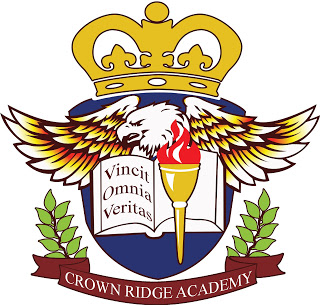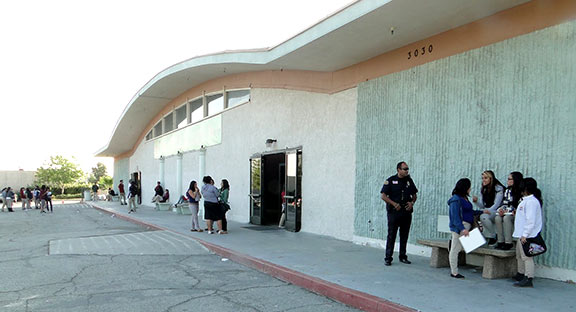Crown Ridge Academy
Crown Ridge Academy
Grades: 9-12
Public charter
San Bernardino City Unified School District
150 students
3030 Del Rosa Avenue
San Bernardino, CA 92404

Crown Ridge Academy was a charter high school in San Bernardino. The principal of Crown Ridge Academy was Florante Parrenas, who can be contacted at ceo@parrenas.com. 150 students attend Crown Ridge Academy and identify mostly as Multiracial; Hispanic; and Black, non-Hispanic. 39% of the 150 students here get reduced lunch prices.
Services
Crown Ridge Academy offers a functionally strong high school program that focuses on improving and strengthening student skills in mathematics, the sciences, reading and writing.
Credentialed and highly trained teachers deliver the curriculum in a manner that engages the students and cause them to be directly involved and responsible for their own development with the support of the school and their parents.
Crown Ridge creates an academic environment in consortium with Project Lead the Way, a national not-for-profit organization established to help schools give students the knowledge they need to excel in high-tech fields. Studies have proven that PLTW students become the kind of high-tech employees U.S. industry needs to compete in the global economy. PLTW is all about teaching and learning. The hands-on project/problem based PLTW approach adds rigor to traditional technical programs and relevance to traditional academics.
And while we're talking observations, you can't help noticing some welcome details. Like how immaculate the school kitchen and bathroom facilities are. Cleanliness is expected, but here it's a mantra. From the anti-bacterial rinse that occurs nightly to the choices of dish soap supplies used daily by the staff. The spotlight is on clean with a capital C! Mops, brooms, and cleaning products are selected for their environmental benefit. The school presents a clean, and inviting learning environment.
Crown Ridge offers two sets of curricula: Pathway to Engineering and Biomedical Sciences. Both curricula make math and science relevant for students. By engaging in hands-on, real-world projects, students understand how the skills they are learning in the classroom can be applied in everyday life.
This approach is called activities-based learning, project-based learning, and problem-based learning (or APPB-learning, for short). Research shows that schools practicing APPB-learning experience can increase student motivation, cooperative learning skills, higher-order thinking, and student achievement.
The key components of Project Lead the Way's APPB-learning include:
focusing students on one project over an extended period of time
working cooperatively and effectively as a class or in small groups
integrating mathematics, science, technology, and English language arts skills to solve complex problems.
In addition, students have the option to participate in electives like the performing arts, creative writing, computer and digital technology and gain the confidence of a well-rounded person.

Crown Ridge and College Credits
High school students in PLTW programs who earn qualifying grades have the opportunity to earn college credit for their PLTW courses. For example, our secondary school students who meet the requirements may apply for college credit at institutions such as University of Colorado at Colorado Springs (UCCS), Rochester Institute of Technology (RIT), California Polytechnic State University, Pomona, and other PLTW partners. Detailed information on student credit and recognition from specific colleges is available upon request. To be available for college credit, students must receive at least an 85 percent average in the course, score 70 or above on the college credit exam, and pay a $200 tuition fee per course. Scholarship free grants can be arranged. The course appears on the university transcript. For students who choose to enroll at UCCS, RIT, or other colleges after high school, these classes replace courses in majors such as Computer, Electrical, or Mechanical Engineering.
The High School Focus
The key principles behind Crown Academy's integrated curriculum units are:
The Project Lead the Way strands are designed according to applied learning theory.
Academic core classroom lessons address state and national academic standards that lead to high school graduation and success in postsecondary education.
Each integrated curriculum unit addresses technical knowledge and skill standards that have been validated by industry professionals.
Students work on "essential questions" that require mastering challenging academic and technical content and applying teamwork, critical-thinking, and problem-solving skills.

Pathway to Engineering
Crown Ridge's premier program is Pathway to Engineering, an eight-course opportunity for students seeking a more in-depth, hands-on knowledge of engineering and engineering technologty-based careers. Upon graduation, students will be completely equipped to enter a two or four year college or technical school program in engineering or engineering technology. Entering the workforce either full time or part time will provide Crown Ridge graduates with a competitive advantage over their non-Crown Ridge peers.
Biomedical Sciences
Crown Ridge Academy's Biomedical Sciences curriculum is enhanced with the Project Lead the Way partnership concept. The sequence of high school courses in the Biomedical Sciences Program parallels the proven Pathway to Engineering curriculum. Biomedical sciences is a broad field encompassing many different medical and healthcare disciplines. These include biochemistry, biomedical engineering, dentistry, forensics, microbiology, immunology, pharmacology, physiology, radiological sciences, and more. The Project Lead the Way Biomedical Sciences curriculum gives students the academic foundation to enter any of these fields.
In addition to a scholarship fund, Clean It once again provided the department with a generous donation to be used at our discretion. This is the second year in which the school benefited from the generosity of this cleaning supplies enterprise. The company also gifted 3% of the profits from all online sales of certain products during the 3 week period before the start of school. This inspired a fundraising effort that raised over $20,000 for the school and especially the science department. We are grateful to the Clean It company for enabling us to begin a new lab program focused on local ecology. The first classes begin this fall.
Benefits Beyond the Classroom
The project- and problem-based Project Lead the Way Pathway to Engineering and Biomedical Sciences curricula help students:
- Think creatively and critically
- Solve problems
- Communicate effectively
- Work in teams
- Develop time management and organizational skills
- Understand how scientific research is conducted, applied, and funded.
"Students and teachers love the new PLTW Biomedical Sciences and Pathway to Engineering Programs. The rigorous and relevant curricula include 21st century skills that prepare students for postsecondary education and the workforce. PLTW is truly revolutionizing education."
-Terri Schultz
Leader of Program Innovation,
Indiana State Department of Workforce Development
VISION STATEMENT

Crown Ridge Academy is established on the belief that when high expectations for academic success are partnered with a strong and structured support system, students are academically successful. Crown Ridge recognizes that academic success is only possible with an environment that is structured to address the particular needs and challenges of the student population. Crown Ridge Academy is designed with the following research-based practices:
- Students need to have time devoted to skill acquisition in order to reach proficiency and mastery.
- Students need ample time in their regular program for practice of new career-technology goals.
- Students need opportunities for learning and practice using multiple competencies.
Our Board of Directors
Steve Bielinski, MD., Consultant to specialty providers in the nutritional industry and medical projects, Board
Director and Medical Director of Health Hyperlink, Inc., Loma Linda, CA. Dr. Steve Bielinski, a graduate of Loma Linda University School of Medicine, has a long history of biomedical research and innovation. He is an experienced physician in the delivery of emergency/urgent care medicine, capable of accommodating high acuity, heavy patient volume while maintaining quality-of-care and a warm bedside manner. His focus on novel health promotion concepts and products has widened his knowledge and skill in human nutrition and behavior modification inside the traditional allopathic model. He is an experienced “hands-on executive” with a proven track record developing effective lifestyle modification and obesity management systems, sales, marketing, and medical-community public relations for consumer health products of international and multi division scope. He is comfortable speaking before large audiences, including radio and television appearances. His engaging style effectively communicates his invitation to step through the door of change and his innovative programs provide support for those who take that step. As Medical Director of Health Hyperlink, a nonprofit foundation, he seeks to expand awareness of the critical importance of a plant-based diet to health and longevity and bring the universities research on the subject to public attention.
The Founding Group
Dr. Florante Parrenas has been a practicing consultant in administration, planning and social policy for many years. He is an experienced school administrator with a successful track record in curriculum, instruction and educational management in all academic levels.. He is a published author. He graduated from Harvard University, Cambridge, MA. He is also greatly involved in social justice projects worldwide.
Arthur Prouty has a strong experience in organization and governance from his civil and military services as management analyst for the Military Assistance Program (MAP) under Commander-in-Chief, Pacific (CINC PAC) pertaining to South East Asia Treaty Organization (SEATO). He was the administrative officer for the Department of Defense Dependent Schools in the Pacific Region (DODDS-P) for many years.
Dr. Cecilia Salazar Parrenas is
an experienced teacher with a strong background in literacy development and academic assessment. She is a recipient of the MONTE Award for Most Outstanding Elementary Educator, San Bernardino City Unified School District. She is a fellow of the California Reading and Literature Project of Center X, GSEIS,
University of California Los Angeles. She was a postdoctoral fellow in Bilingual Education at Boston University, MA. She has been consulting in the areas of curiculum and instruction and conducts workshops on Developing Literacy, Reading, and Assessment worldwide.
Zenaida G. Prouty is a public school teacher with extensive experience in best teaching practices. She was an Associate Professor of Humanities at the University of Eastern Philippines.
Rhanee S. Parrenas is a graduate of the University of California, Berkeley with a major in Women's Studies and Rhetoric and a minor in Ethnic Studies. She is currently the Employer Representative for the Marriott Foundation,
Bridges from School to Work Program. The program develops and supports mutually beneficial job placements to meet the workforce needs of local employers and the vocational goals of young people.
+++
Dreams Come True
Today's heroes aren't only the ones scoring touchdowns and making movies, they're also the ones finding cures to diseases, using advanced forensic techniques to solve crimes, developing high-tech medical devices that improve and save lives, designing digital technologies that make life easier, and providing the expert care that helps patients reach their highest potential for health.
That's the result of studying engineering or biomedical sciences. Each is a cutting-edge, it's exciting, and it's a field where any kid who wants to be a superstar can find a place to shine.
"At last, there's a school that's serious about building my future in the biomedical sciences, a field I want to explore.!" - Aari Kabari
"The The opportunity to combine academic work with a career path in biomedical sciences does not come by easily. I'm glad I have this opportunity. I may yet become a doctor!" -Alan
"The The opportunity to combine academic work with a career path in biomedical sciences does not come by easily. I'm glad I have this opportunity. I may yet become a doctor!" -Alan Windisch
"Everything in life is about engineering one way or another. Young girls should know that an engineering degree can take them just about anywhere. Many women engineers have already paved the way. The only limit you have is yourself!" - Shannon Prouty
"To gain the expertise of people in industry, get a good head start at Crown Ridge Academy." - Dr. P
